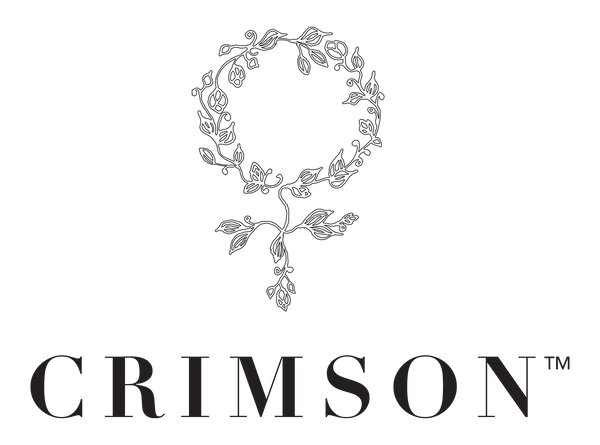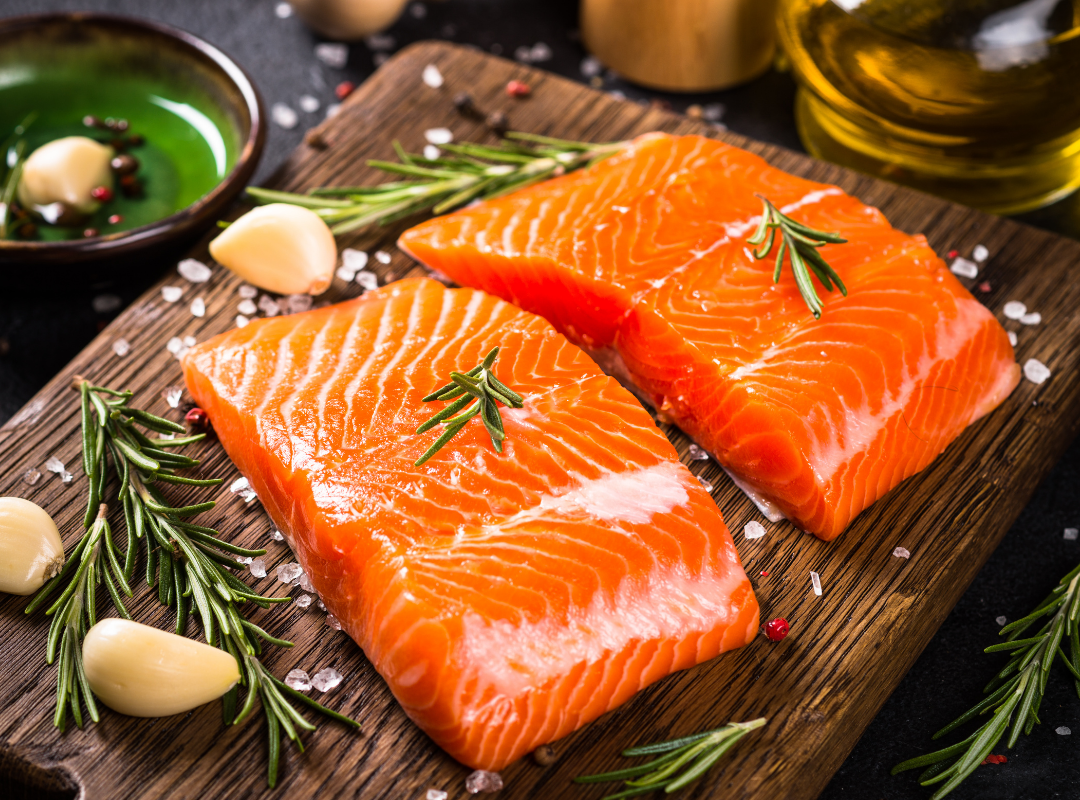
What Foods Help Period Cramps? Top Tips for Relief in 2025
Share
Periods are a natural part of life, but debilitating cramps don't have to be. Many of us have been there – curled up on the couch, wishing for a quick solution. While there's no single magic fix, your kitchen pantry holds some surprisingly powerful allies in the fight against menstrual pain. Here in New Zealand, as we champion conversations around period equity and challenge outdated stigmas, empowering ourselves with knowledge is more important than ever. This isn't just about surviving your period; it's about thriving through it.
This guide moves beyond generic advice to explore the science behind what foods help period cramps, offering practical and delicious ways to ease discomfort. We'll examine how specific nutrients work to relax your muscles, reduce inflammation, and help balance your hormones naturally. By understanding the connection between diet and your cycle, you can feel more in control. Let's uncover how simple, mindful food choices, paired with reliable and sustainable period care like digital (non-applicator) tampons, can transform your monthly experience from one of dread to one of empowered wellbeing. You'll learn exactly which foods to reach for and why they are so effective, helping you build a supportive toolkit for a more comfortable period.
1. Dark Leafy Greens (Spinach, Kale, Swiss Chard)
When menstrual cramps strike, reaching for a hearty salad or a warm bowl of sautéed greens might be one of the most effective strategies. Dark leafy greens like spinach, kale, and Swiss chard are nutritional powerhouses, uniquely equipped to combat the pain and fatigue associated with your period. They are exceptionally rich in iron, magnesium, and calcium, three key nutrients that directly address the root causes of menstrual discomfort.
During menstruation, your body loses iron, which can lead to feelings of exhaustion and low energy. Replenishing this mineral is crucial. More importantly, the magnesium and calcium found in these greens work together to soothe the uterine muscles. Magnesium acts as a natural muscle relaxant, helping to ease the intense contractions of the uterus that cause cramping.
How Greens Provide Relief
The science behind this is compelling. Magnesium helps regulate nerve and muscle function, and adequate levels can significantly reduce the production of prostaglandins, the hormone-like substances responsible for period pain.
- Iron Replenishment: Counteracts fatigue and sluggishness caused by blood loss.
- Muscle Relaxation: High magnesium content helps calm uterine contractions.
- Calcium Boost: Works with magnesium to maintain muscle tone and reduce painful spasms.
This infographic highlights just how impactful incorporating dark leafy greens can be for managing menstrual symptoms.
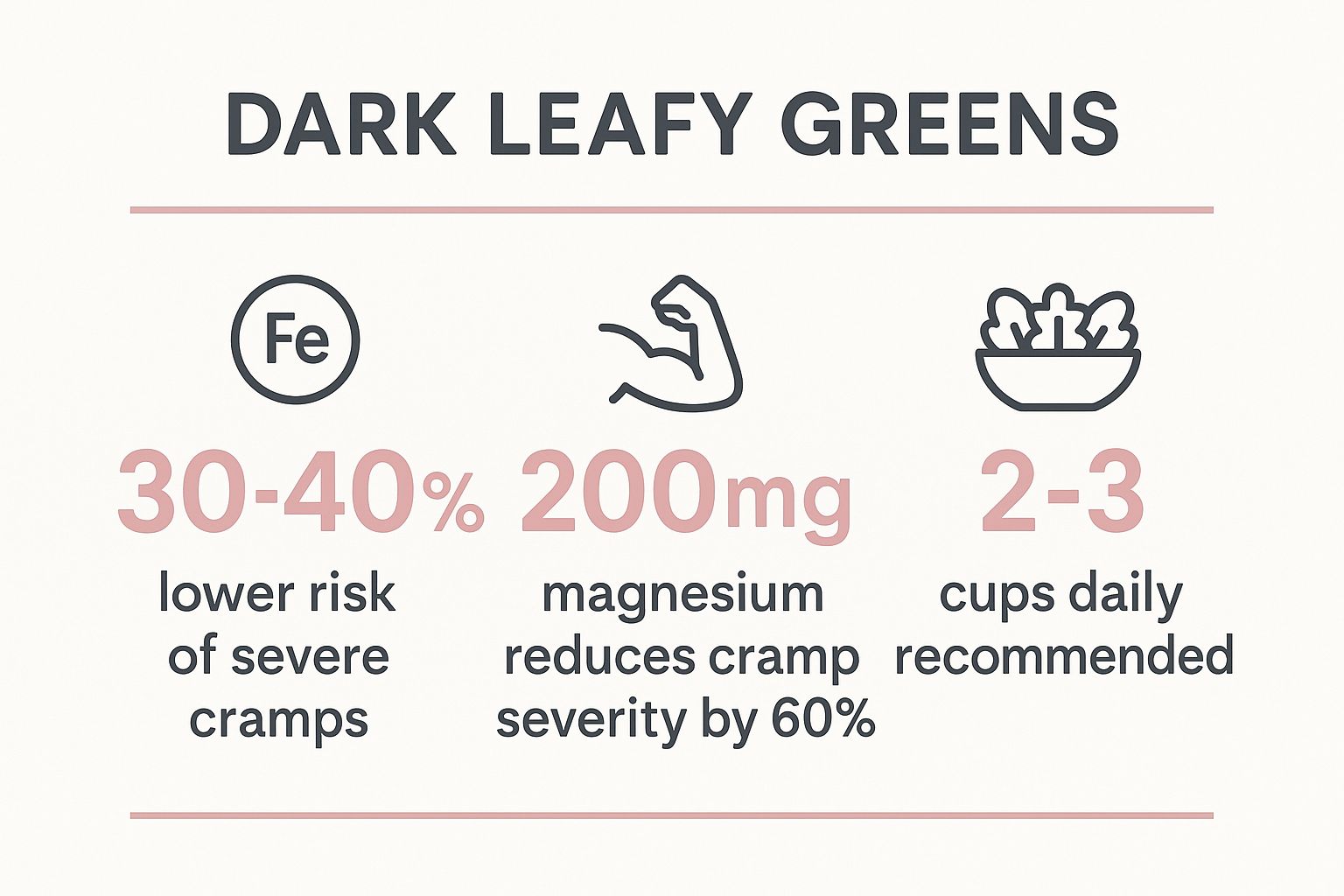
The data clearly shows that a consistent intake of nutrient-dense greens can lead to a substantial reduction in cramp severity and overall risk.
Practical Ways to Eat More Greens
Integrating these vegetables into your diet is simpler than you might think. Consistency is key, so aim to eat them throughout the month, not just during your period.
- Boost Your Smoothies: Add a large handful of spinach or kale to your morning smoothie. You won't taste it, but you'll get all the benefits.
- Steam and Season: Lightly steaming greens helps make their nutrients more bioavailable. Drizzle with lemon juice (a source of vitamin C) to enhance iron absorption.
- Wilt into Meals: Stir chopped kale or Swiss chard into soups, stews, pasta sauces, or scrambled eggs in the last few minutes of cooking.
By proactively including these foods in your routine, you are supporting a healthier, more comfortable menstrual cycle. To discover more about how your diet can influence your period, you can find further insights on foods to help support a healthy menstrual cycle.
2. Fatty Fish (Salmon, Mackerel, Sardines)
Incorporating fatty fish like salmon, mackerel, and sardines into your diet can be a game-changer for managing menstrual pain. These fish are renowned for their high concentration of omega-3 fatty acids, particularly EPA (eicosapentaenoic acid) and DHA (docosahexaenoic acid). These powerful compounds act as natural anti-inflammatory agents, directly targeting one of the primary culprits behind severe period cramps.
By reducing inflammation throughout the body, omega-3s help to lower the production of prostaglandins. These are the hormone-like substances that cause the uterus to contract forcefully, leading to the familiar and often debilitating pain experienced during menstruation. Including these healthy fats in your meals is a proactive way to calm your system and ease discomfort from the inside out.
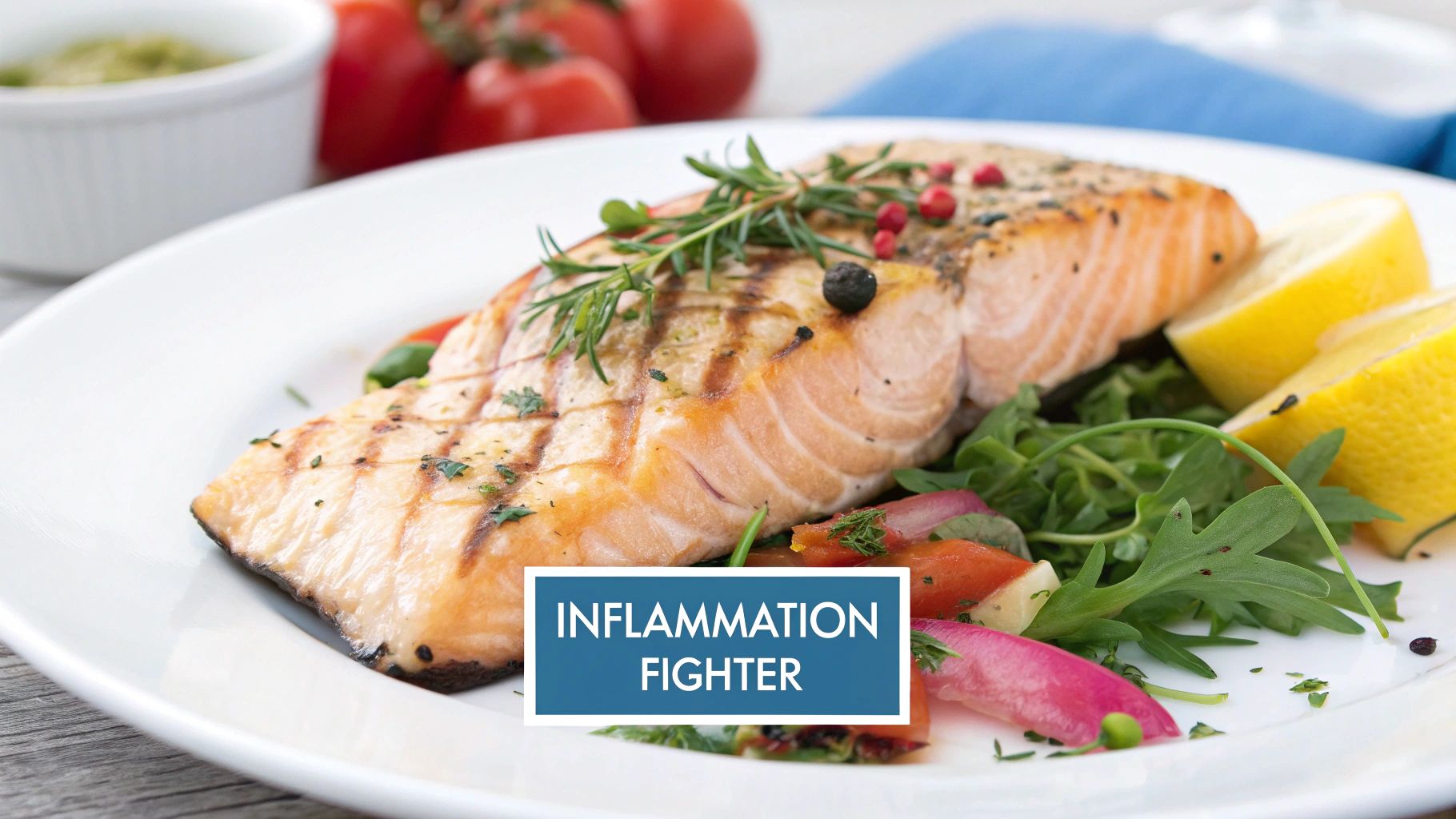
How Fatty Fish Provide Relief
The anti-inflammatory properties of omega-3s are well-documented and provide a strong scientific basis for their effectiveness. Research, including clinical trials, has shown that a regular intake of these fatty acids can significantly decrease the intensity of menstrual pain, often reducing the need for over-the-counter pain relievers. This is why diets rich in fish, like the Mediterranean diet, are often associated with better menstrual health.
- Prostaglandin Reduction: Omega-3s interfere with the production pathway of inflammatory prostaglandins.
- Natural Anti-inflammatory: They help calm the body's overall inflammatory response, easing uterine muscle tension.
- Mood Support: DHA is crucial for brain health and may help alleviate the mood swings often associated with PMS.
The evidence is clear: consuming fatty fish is a powerful, natural strategy to tackle period cramps head-on. This approach is widely supported by integrative medicine experts like Dr. Andrew Weil and various Nordic nutrition researchers.
Practical Ways to Eat More Fatty Fish
The key to reaping the benefits is consistency. Aim to include fatty fish in your diet throughout the month, not just when you have your period. It’s about building up your body's reserves of these crucial anti-inflammatory fats.
- Aim for Two Servings: Try to eat at least two to three servings of fatty fish each week. Start increasing your intake a week or two before your period is due for maximum effect.
- Choose Smart Cooking Methods: Grill, bake, or steam your fish to preserve its delicate omega-3s. Frying at high temperatures can damage these healthy fats.
- Easy Meal Ideas: Add flaked smoked salmon to scrambled eggs, toss canned sardines through a salad, or enjoy a baked salmon fillet with steamed greens for a nutrient-packed meal.
Making fatty fish a regular part of your eating habits can lead to a noticeable improvement in your monthly cycle, helping you feel more in control and comfortable. For more ideas on building a supportive diet, you can learn about other foods that help with period pain.
3. Dark Chocolate (70% Cacao or Higher)
Indulging in a piece of high-quality dark chocolate during your period isn't just a comfort craving; it's a scientifically-backed strategy for pain relief. Dark chocolate with a cacao content of 70% or higher is a rich source of magnesium and iron, two critical minerals that help combat menstrual discomfort. It also contains unique compounds that encourage the brain to release endorphins, which are natural pain relievers and mood elevators.
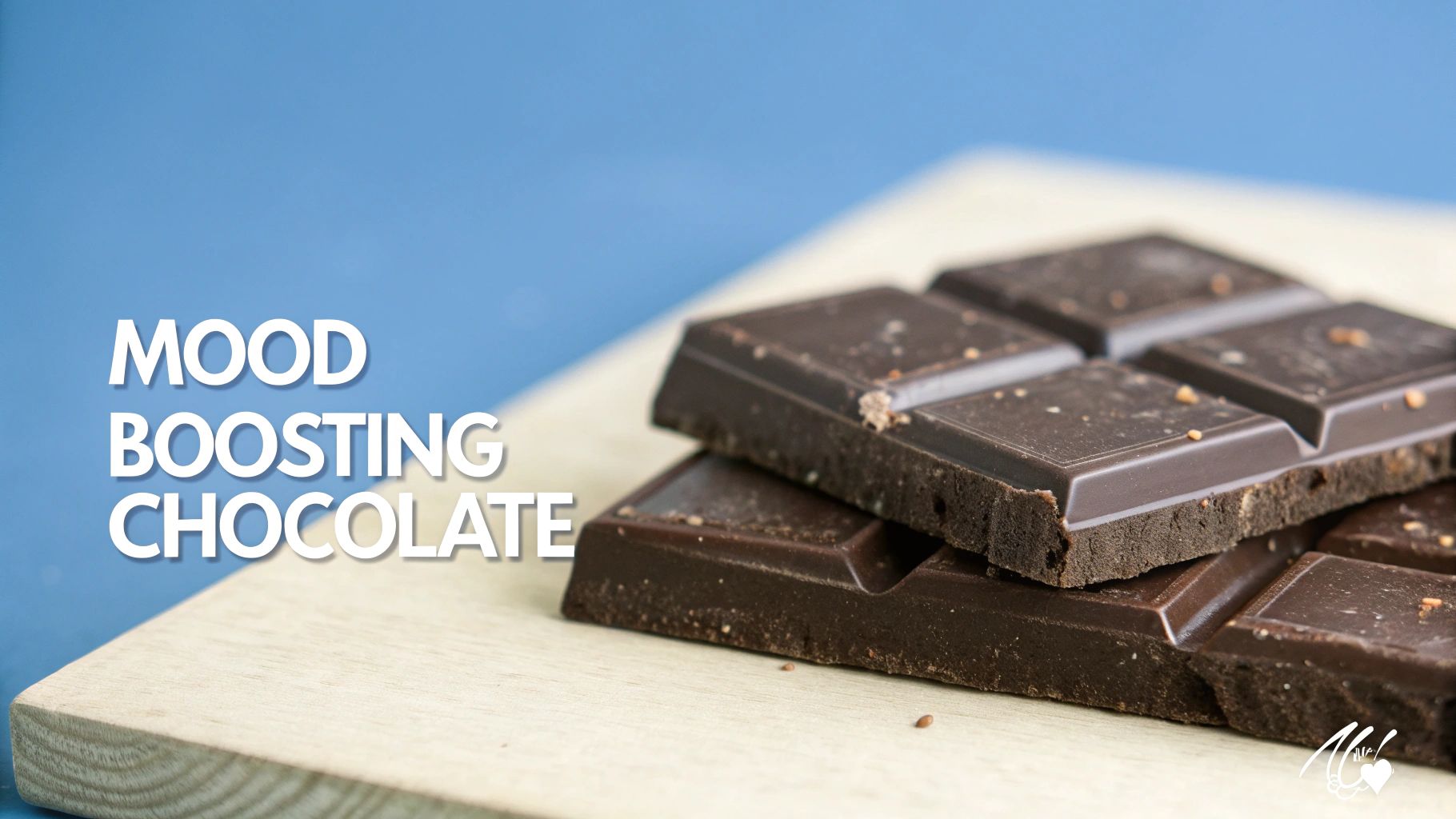
The magnesium in dark chocolate functions as a natural muscle relaxant, helping to ease the uterine contractions that cause cramping pain. At the same time, its iron content helps to replenish what is lost through menstrual bleeding, fighting off the fatigue that so often accompanies your period. This makes dark chocolate one of the more enjoyable foods that help period cramps.
How Dark Chocolate Provides Relief
The magic lies in its potent blend of minerals and antioxidants. Magnesium helps to lower levels of prostaglandins, the compounds that trigger uterine cramping. Meanwhile, the flavonoids in dark chocolate have anti-inflammatory properties, further reducing pain and discomfort. This dual-action approach makes it a powerful addition to your period care routine.
- Magnesium Power: Acts as a muscle relaxant to soothe uterine contractions.
- Endorphin Release: Theobromine and other compounds boost mood and provide natural pain relief.
- Iron Replenishment: Helps to restore energy levels and combat period-related fatigue.
Clinical studies back this up. Research has shown that daily consumption of a small amount of dark chocolate (around 40g) can lead to a significant reduction in menstrual pain. This simple dietary addition, popularised by women's health experts like Dr. Christiane Northrup, can make a noticeable difference.
Practical Ways to Enjoy Dark Chocolate
To get the most benefit, it's important to choose the right kind of chocolate and consume it mindfully. The key is moderation and quality, making it a sustainable practice throughout the month.
- Choose High Cacao: Opt for a bar with at least 70% cacao content. The higher the percentage, the more magnesium and antioxidants it contains and the less sugar.
- Mindful Portions: Stick to a small portion, about 1-2 squares (30-40 grams) per day, to get the benefits without excess sugar or caffeine.
- Pair It Wisely: Enjoy a square of dark chocolate with a handful of magnesium-rich almonds or alongside a cup of ginger tea to amplify the cramp-fighting effects.
By making a conscious choice to include high-quality dark chocolate in your diet, you can support your body and find a delicious source of relief. To learn more about holistic approaches to menstrual wellness, explore the insights on our Crimson blog.
4. Bananas
Often praised by athletes for preventing muscle cramps, the humble banana is also a powerful ally against menstrual pain. This accessible fruit is packed with potassium, magnesium, and vitamin B6, a trio of nutrients that work synergistically to alleviate some of the most common period-related complaints. Their natural sweetness also offers a healthy way to satisfy sugar cravings that can spike during menstruation.
The potassium in bananas is key for regulating fluid balance, which can help reduce the uncomfortable bloating that often accompanies your period. Meanwhile, like the magnesium found in leafy greens, the magnesium in bananas acts as a natural muscle relaxant, helping to ease the uterine contractions that cause cramping. Vitamin B6 plays a crucial role in producing neurotransmitters like serotonin and dopamine, which can help lift your mood and manage pain perception.
How Bananas Provide Relief
The combination of these nutrients makes bananas an excellent, easy-to-eat option when considering what foods help period cramps. Many traditional medicine practices in tropical countries have long utilised bananas for various aspects of women's health, and modern science now supports this wisdom.
- Bloating Reduction: High potassium content helps your body manage fluid retention.
- Muscle Relaxation: Magnesium works to soothe uterine muscle spasms and reduce cramp intensity.
- Mood and Pain Management: Vitamin B6 contributes to the production of mood-regulating neurotransmitters, helping you feel better both physically and emotionally.
Incorporating this simple fruit into your diet, especially in the days leading up to and during your period, can make a noticeable difference in your comfort levels.
Practical Ways to Eat More Bananas
Making bananas a regular part of your diet is straightforward and delicious. Aim for consistency to maximise the benefits for your menstrual cycle.
- Start Your Day Right: Slice a banana over your morning oatmeal, cereal, or yoghurt for a nutrient-enhanced breakfast.
- Blend into Smoothies: Frozen bananas create a wonderfully creamy base for smoothies. Combine with spinach and berries for a cramp-fighting super drink.
- Smart Snacking: Simply eat one on its own as a convenient, on-the-go snack. For lower sugar content, choose bananas that are still slightly green.
By proactively including bananas in your routine, you are giving your body valuable tools to manage menstrual symptoms naturally. To learn more about holistic approaches to your cycle, explore our insights on creating a more positive period experience.
5. Ginger
For centuries, ginger has been a staple in traditional medicine for its powerful soothing properties, and when it comes to menstrual cramps, it truly shines. This spicy, aromatic root is more than just a flavour enhancer; it's a potent natural remedy packed with anti-inflammatory compounds called gingerols and shogaols. These bioactive components work to reduce the body's production of prostaglandins, the inflammatory chemicals responsible for the painful uterine contractions during your period.
The effectiveness of ginger is not just anecdotal. Modern scientific research has validated its traditional use, with several clinical studies showing that ginger can be as effective as common over-the-counter pain relievers like ibuprofen for alleviating menstrual pain. This makes it a fantastic, natural alternative for those seeking relief without turning to pharmaceuticals, aligning with a more holistic approach to managing what foods help period cramps.
How Ginger Provides Relief
The science behind ginger’s pain-relieving power lies in its ability to inhibit the enzymes that create inflammatory prostaglandins. By lowering the levels of these compounds, ginger directly targets the source of the cramping, offering a calming effect on the uterine muscles.
- Anti-Inflammatory Action: The active compound, gingerol, significantly reduces inflammation and pain signalling.
- Prostaglandin Reduction: Directly lowers the hormone-like substances that trigger intense muscle contractions.
- Proven Efficacy: Clinical trials have demonstrated up to a 62% reduction in menstrual pain with consistent use.
This powerful root has been a cornerstone of Traditional Chinese Medicine and Ayurvedic practices for treating menstrual issues, a testament to its long-standing success.
The video above provides further insight into the scientific backing for ginger as a natural pain management tool.
Practical Ways to Use Ginger
Incorporating ginger into your diet is simple and can make a significant difference. For best results, start consuming it a couple of days before you expect your period to begin.
- Brew Fresh Ginger Tea: Steep a few thin slices of fresh ginger root in hot water for 5-10 minutes. Add a squeeze of lemon or a dash of honey for flavour.
- Add to Meals: Grate or finely chop fresh ginger and add it to stir-fries, curries, soups, and marinades for a warming, zesty kick.
- Ginger in Smoothies: A small piece of fresh ginger can add a powerful anti-inflammatory boost to your morning smoothie.
By making this potent root a regular part of your routine, you are embracing a time-tested method for achieving a more comfortable cycle. For more ideas on natural solutions, you can explore other options for period pain relief in NZ.
6. Turmeric
When dealing with menstrual pain, incorporating the vibrant golden spice turmeric into your diet can be a game-changer. Used for centuries in traditional medicine, particularly Ayurveda, turmeric contains a powerful compound called curcumin. This active ingredient is celebrated for its potent anti-inflammatory properties, making it a natural and effective tool for combating the discomfort associated with your period.
Turmeric works by directly targeting inflammation, a key driver of period pain. The intense uterine contractions that cause cramps are triggered by inflammatory compounds called prostaglandins. Curcumin helps to inhibit the pathways that produce these compounds, leading to less severe cramping and a more manageable cycle. Its ability to soothe the body's inflammatory response offers a gentle yet powerful form of relief.
How Turmeric Provides Relief
The science behind turmeric's effectiveness is robust and well-documented. Curcumin's ability to modulate inflammation at a molecular level makes it one of the most studied natural remedies for pain. Research, including clinical studies using curcumin supplements, has shown significant reductions in menstrual pain severity among participants.
- Anti-Inflammatory Action: Curcumin helps to lower the production of prostaglandins, which are responsible for painful uterine contractions.
- Hormonal Regulation: It may assist in balancing hormonal fluctuations that can exacerbate menstrual symptoms.
- Natural Pain Relief: It functions as a natural analgesic, helping to reduce the overall perception of pain without the side effects of some over-the-counter medications.
This natural approach aligns with a holistic view of menstrual health, focusing on what foods help period cramps by addressing root causes rather than just masking symptoms. The long-standing use of turmeric in Indian traditional medicine, where women often report less menstrual pain, highlights its efficacy.
Practical Ways to Eat More Turmeric
Adding this beneficial spice to your daily routine is simple. For the best results, aim to consume it regularly throughout the month, not just when pain strikes.
- Make a Golden Milk Latte: Whisk a teaspoon of turmeric powder into a cup of warm milk or a plant-based alternative like oat or almond milk. Add a pinch of black pepper, as its piperine compound can increase curcumin absorption by up to 2000%.
- Spice Up Your Meals: Add fresh or powdered turmeric to curries, soups, stews, roasted vegetables, or scrambled eggs for a warm, earthy flavour and a vibrant colour.
- Consider a Supplement: For a more concentrated dose, you could consider a standardised curcumin supplement, often recommended at around 500mg daily, but it's always best to consult with a healthcare professional first.
7. Quinoa and Whole Grains
When looking for what foods help period cramps, whole grains like quinoa, brown rice, and oats should be at the top of your list. These complex carbohydrates offer a steady release of energy, helping to stabilise blood sugar levels and prevent the energy crashes that can worsen mood swings during your period. They are also packed with B vitamins and magnesium, a powerful combination for fighting menstrual pain and discomfort.
Whole grains are particularly effective because of their high magnesium content. Similar to dark leafy greens, magnesium functions as a natural muscle relaxant, helping to calm the uterine contractions that are the primary source of cramping. The B vitamins contribute by supporting energy production and helping to synthesise neurotransmitters like serotonin, which can improve your mood and help your body manage pain more effectively.
How Whole Grains Provide Relief
The science supports the connection between whole grain consumption and reduced menstrual symptoms. Complex carbohydrates provide sustained energy, while key nutrients directly target the mechanisms of period pain. Studies have shown that women who consume several servings of whole grains daily often report less severe premenstrual syndrome (PMS) and cramping.
- Blood Sugar Stabilisation: Complex carbs prevent sharp spikes and drops in blood sugar, which helps regulate mood and energy.
- Muscle Relaxation: Magnesium works to soothe uterine spasms and reduce the intensity of cramps.
- Mood Support: B vitamins and fibre aid in the production of serotonin, a mood-boosting neurotransmitter that also influences pain perception.
By choosing whole grains over refined carbohydrates like white bread or pastries, you are providing your body with the fuel and nutrients it needs to navigate your cycle more comfortably.
Practical Ways to Eat More Whole Grains
Incorporating quinoa and other whole grains into your meals is an easy and delicious way to support your menstrual health. Focus on adding them to your diet consistently throughout the month.
- Start with Breakfast: Choose steel-cut or rolled oats over instant varieties for a slow-releasing, fibre-rich breakfast.
- Batch Cook for Convenience: Cook a large batch of quinoa or brown rice at the start of the week. You can then easily add it to salads, soups, or as a side for dinner. Remember to rinse quinoa before cooking to remove its natural bitter coating.
- Build a Nourishing Bowl: Create a balanced meal by using quinoa as a base and topping it with roasted vegetables, a lean protein like chickpeas or chicken, and a healthy fat like avocado.
Making these simple swaps can make a significant difference in your experience with menstrual pain. To explore other natural strategies, you can find more information on effective period pain relief.
7 Foods That Ease Period Cramps Comparison
| Item | Implementation Complexity 🔄 | Resource Requirements ⚡ | Expected Outcomes 📊 | Ideal Use Cases 💡 | Key Advantages ⭐ |
|---|---|---|---|---|---|
| Dark Leafy Greens | Low – easy to add daily meals | Low – widely available, low cost | Moderate to high – reduces cramp severity by up to 60% | Daily consumption during and before periods | High in iron & magnesium, multiple pain-fighting compounds |
| Fatty Fish | Moderate – requires preparation and storage | Moderate to high – can be costly, needs fresh supply | High – clinically shown 50% cramp intensity reduction | Regular intake (2-3 servings/week) year-round | Potent omega-3 anti-inflammatory, mood support |
| Dark Chocolate (70% Cacao+) | Low – ready to consume | Moderate – cost varies, easy to store | Moderate – 30% cramp severity reduction, mood boost | Quick mood & pain relief, snack option | Magnesium-rich, stimulates endorphins |
| Bananas | Very low – simple to eat anytime | Very low – inexpensive, widely available | Moderate – supports muscle relaxation, mood stabilization | Pre-period and during PMS symptoms | Easy energy source, potassium for bloating relief |
| Ginger | Low to moderate – various prep methods | Low – fresh or powdered form, affordable | High – comparable to ibuprofen, fast acting (30-60 mins) | Acute pain relief, nausea and digestion support | Powerful anti-inflammatory, versatile usage |
| Turmeric | Moderate – needs combination with black pepper | Low to moderate – spice or supplements available | High – up to 70% reduction in pain with proper dosage | Daily use for inflammation and hormonal support | Strong anti-inflammatory, hormone regulation |
| Quinoa and Whole Grains | Moderate – longer cooking times | Moderate – pricier than refined grains | Moderate – mood stabilization, sustained energy | Daily meals to prevent blood sugar crashes | Rich in magnesium, protein, fiber |
Crafting Your Personal Period Comfort Plan
Navigating your menstrual cycle doesn't have to be a monthly battle against discomfort. As we've explored, understanding what foods help period cramps is a powerful first step towards reclaiming control and feeling your best. It's not about imposing a strict, flavourless diet, but rather about consciously choosing to nourish your body with powerful, anti-inflammatory, and muscle-relaxing nutrients.
The true magic happens when you start to see these foods not as individual remedies, but as components of your unique wellness toolkit. Think of it as a personalised strategy, where you listen to your body’s cues and respond with compassion and care. Perhaps one month, the warming spice of a ginger and turmeric tea is exactly what you need, while another month, the steady energy from a bowl of quinoa and leafy greens provides the foundation for a more comfortable week.
Key Takeaways for Lasting Comfort
Let's distill the core principles from this guide into actionable steps you can start implementing today:
- Focus on Anti-Inflammatories: The omega-3s in fatty fish and the curcumin in turmeric are your allies in actively reducing the prostaglandin production that drives cramps. Making these a regular part of your diet, especially in the week leading up to your period, can make a significant difference.
- Prioritise Key Minerals: Don't underestimate the power of magnesium, found abundantly in dark chocolate, bananas, and leafy greens. It’s nature’s muscle relaxant, directly helping to ease the uterine contractions that cause pain. Likewise, iron from greens and whole grains helps combat the fatigue that often accompanies menstruation.
- Build a Proactive Routine: The most effective approach is a consistent one. Instead of waiting for the first twinge of pain, try incorporating these foods into your meals throughout the month. This builds up your body's nutritional reserves, creating a more resilient and balanced internal environment.
A Holistic Approach to Your Cycle
Embracing this food-first strategy is a vital piece of the puzzle, but creating a truly comfortable period experience is a holistic endeavour. It involves pairing intentional nutrition with high-quality period care that respects both your body and the environment. Choosing products free from harsh chemicals and plastics is an act of self-care.
Here in New Zealand, we're becoming more aware of the importance of period equity, ensuring everyone has access to safe, effective products and the knowledge to manage their cycle with dignity. This movement aligns perfectly with taking personal control of your wellbeing. By consciously selecting both the food you eat and the period care you use—like comfortable and reliable digital tampons—you are championing a healthier, more empowered approach to menstruation for yourself and contributing to a more supportive culture across Aotearoa.
Ultimately, mastering your diet is about creating a symbiotic relationship with your body. It's about transforming your period from a time of dread into a time of mindful self-care, proving that with the right knowledge and tools, you can feel strong, nourished, and comfortable every day of the month.
Ready to pair your nutritional strategy with superior period care? At Crimson Organic, we provide certified organic cotton tampons and innovative comfort solutions designed for a healthier, more comfortable cycle. Explore our range and discover how conscious choices can transform your period experience at Crimson Organic.
